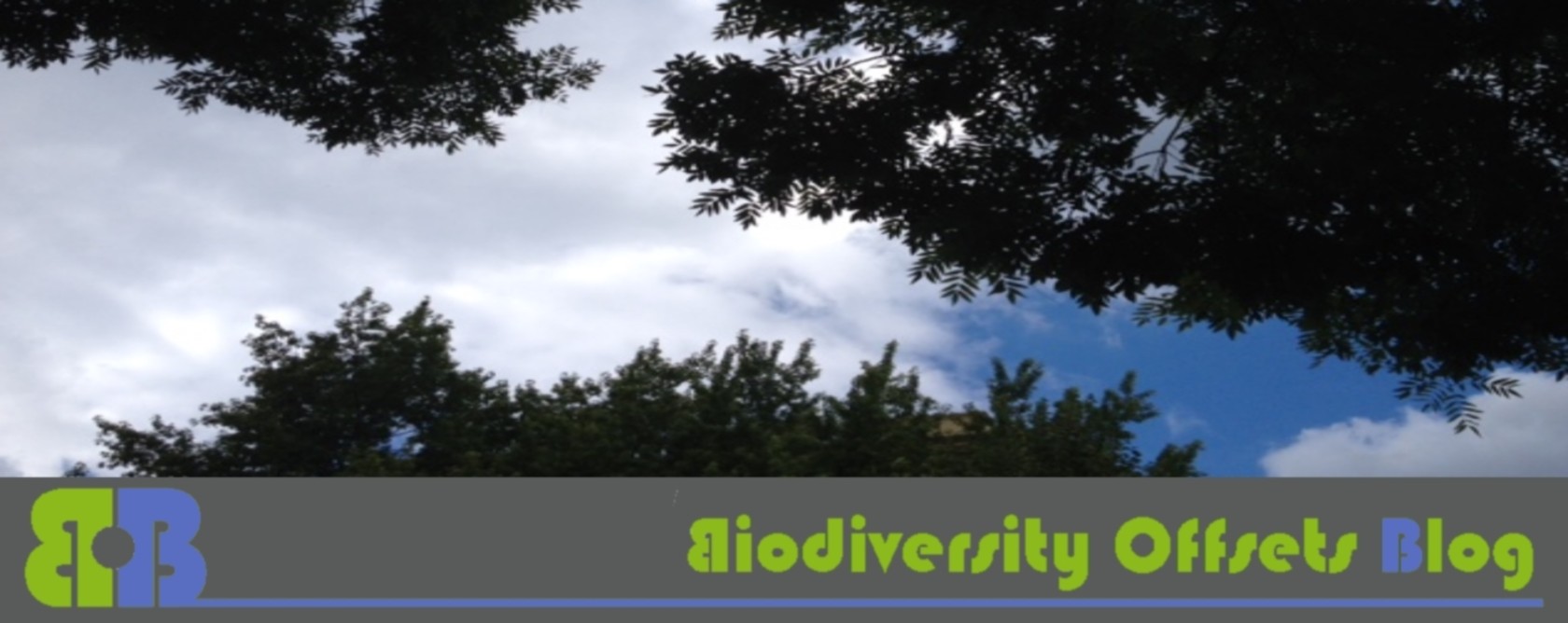 With the adoption of its 2020 Biodiversity Strategy the EU has made a commitment to halt “the loss of biodiversity and the degradation of ecosystem services in the EU by 2020, and restoring them in so far as feasible”. To reach this goal the European Commission works towards an initiative to ensure there is no net loss of ecosystems and their services (e.g. through compensation or offsetting schemes) by 2015. This action is accompanied by a public consultation on the planned No Net Loss Initiative (see my previous post for more details). The discussion on the introduction of biodiversity offsets as part of this initiative is very lively and controversial: some expect a European legal framework on biodiversity offsets would set minimum standards to protect and restore the normal landscape outside protected areas, others fear that this would foster even more development and environmental degradation.
With the adoption of its 2020 Biodiversity Strategy the EU has made a commitment to halt “the loss of biodiversity and the degradation of ecosystem services in the EU by 2020, and restoring them in so far as feasible”. To reach this goal the European Commission works towards an initiative to ensure there is no net loss of ecosystems and their services (e.g. through compensation or offsetting schemes) by 2015. This action is accompanied by a public consultation on the planned No Net Loss Initiative (see my previous post for more details). The discussion on the introduction of biodiversity offsets as part of this initiative is very lively and controversial: some expect a European legal framework on biodiversity offsets would set minimum standards to protect and restore the normal landscape outside protected areas, others fear that this would foster even more development and environmental degradation.
This post is the second in a short-run series on the Biodiversity Offset Blog encouraging you to have your say on the consultation on the EU No Net Loss Initiative until Friday, October17 (consultation closes) and to help you to make an informed decision.
Arguments against biodiversity offsets as part of the EU No Net Loss Initiative from Finance & Trade Watch
The following arguments where extracted from a fact sheet on biodiversity offsets (Finance and Trade Watch Fact Sheet Biodiversitäts-Offsets, in German language) prepared in September 2014 by ECA Watch Austria and Finance & Trade Watch.
- Biodiversity offsets foster the illusion that we can continue our excessive land-take
- Through the financialization nature is becoming a tradable commodity
- Nature and biodiversity can’t be measured and quantified (in money or units) and thus is not exchangeable
- Biodiversity offsets can’t guarantee to compensate all biodiversity loss, because natural systems are too complex and may take long to recover
- Nature conservation measures as part of biodiversity offsets only occur if nature degradation takes place first.
- Biodiversity offsets will most likely result in market based approaches that bear a higher risk of fraud with regard to additionality and perpetuity as well as quality of the measures.
- Current practice shows that the mitigation hierarchy is not always properly enforced, i.e. projects are approved BECAUSE biodiversity offsets are proposed for the negative impacts.
- Biodiversity offsets are worse than nothing – they are a license to trash nature and legitimize the excessive over-consumption of nature.
Arguments against biodiversity offsets as part of the EU No Net Loss Initiative from FERN
He following arguments and pictures were taken from two briefing notes on biodiversity offsets prepared by the NGO FERN (FERN Briefing note 2 What is biodiversity offsetting and why is it problematic, FERN Briefing note 3 Biodiversity offsetting in practice).
- Existing biodiversity offset systems (like in the US or Australia) haven’t proven to be a success.
- Biodiversity offsets mean measuring the unmeasurable.
- Offsets lead to a net loss of biodiversity, i.e. most offset sites have less biodiversity than the sites that were destroyed.
- Whereas biodiversity losses are guaranteed, future gains may be realized late or not at all, i.e. ‘time lag’ of offsets (the gap between the development occurring and the offset’s benefits accruing) also means there can be a serious ‘interim’ loss of biodiversity.
- Public authorities do not have the resources — nor the will — to bring penalties when offsets do not meet their requirements.
- Biodiversity offsets can be a license to trash, i.e. offsetting is used to greenwash planning applications and speed them through the planning system, with no consideration for avoidance and mitigation
- On first impressions, the NNLI appears to be a positive commitment, but its implication that biodiversity loss does not need to be reversed but kept stable is worrying.
- It also oversimplifies a complex issue. Biodiversity’s complexity and interconnectedness make implementing biodiversity offsetting schemes problematic.
- To be credible, large amounts of data have to be gathered and analyzed on various sites and then valued. This demands a high level of expertise – and would involve considerable expenditure.
- The developer would have considerable power and influence over the process. This might mean the environmental impact of a project might be underestimated.
- Those involved in biodiversity offsetting talk in terms of targets for replaced biodiversity rather than of certainties. The trouble is that if the target is not achieved, an area’s biodiversity is lost, never to be regained.
- Strong governance is vital in biodiversity offsetting: once a scheme is implemented, it has to be properly — and independently — monitored in the long term. Given the different governance regimes within the EU and the fact that expertise and the necessary manpower is likely to be lacking in many areas this can’t be assured.
- To date, biodiversity offsetting has focused only on the bartering or swapping of various sites of biodiversity: it has not attempted to deal with the considerable social value biodiversity provides to communities on a recreational, spiritual and cultural level, i.e. communities lose access to nature.
- Biodiversity offsetting also ignores the other benefits nature provides to a community, i.e. it can also have negative economic consequences, bringing down the value of nearby housing and generally lessening the attractiveness of the neighborhood.
Arguments against biodiversity offsets as part of the EU No Net Loss Initiative from the ”No to Biodiversity Offsetting!” Initiative
The following arguments were extracted from the statement “No to Biodiversity Offsetting!” on the website of the initiative.
- Biodiversity offsets could lead to an increase in damage, but even more concerning is that it commodifies nature.
- Biodiversity offsetting relies on ‘experts’ to create dubious calculations that claim to make one piece of the earth equal to another. It pretends you can trade places.
- The introduction of biodiversity offsetting allows, or even encourages, environmental destruction with the promise that the habitat can be recreated elsewhere.
- With biodiversity offsets the companies doing the damage can present themselves as a company that invests in environmental protection, thereby green-washing its products and services.
- Investors want to profit from so called ‘natural capital’. “Natural capital” is an artificial concept based on questionable economic assumptions rather than ecological values.
- Property rights over elements of nature such as biodiversity can be transferred to corporations and banks.
- Biodiversity offsetting won’t prevent biodiversity loss, because it is impossible to fully measure biodiversity, so suggestions that equivalent natural areas can be found is a fallacy.
- Biodiversity offsetting will harm communities, because biodiversity offsetting means environmental protection becomes a mere by-product of a commercial project, marginalising communities and threatening their right to life. Biodiversity offsetting attempts to separate people from the environment in which they live.
- Past cases of biodiversity offsetting show how it opens up natural resources to further exploitation, and undermines communities’ rights to be able to manage and protect the natural commons.
More from the short-run series on the consultation on the EU No Net Loss Initiative
The short-run series on the Biodiversity Offsets Blog on the consultation on the EU No Net Loss Initiative includes the following posts:
2. Why would you say NO to the EU No Net Loss initiative? (this post)

Pingback: Why would you say YES to the EU No Net Loss Initiative? - Biodiversity Offsets Blog
Pingback: Consultation on the EU No Net Loss Initiative: Biodiversity offsetting can, under certain circumstances, improve nature and biodiversity conservation — a comment by Heidi Wittmer - Biodiversity Offsets Blog
To experts it may concers :
http://www.ma.undp.org/content/morocco/fr/home/operations/procurement/
Hi Moha, I have scheduled a post on this and your project for tomorrow (see here).
Pingback: Have your say – even if it’s a MAYBE: Consultation on the EU No Net Loss Initiative closes today! - Biodiversity Offsets Blog